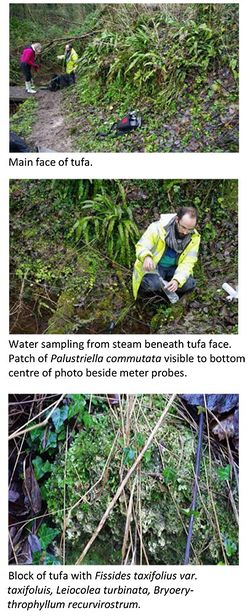OR/14/043 Site description - Ddol
| Farr, G, Graham, J, and Stratford, C. 2014. Survey, characterisation and condition assessment of Palustriella dominated springs 'H7220 Petrifying springs with tufa formation (Cratoneurion)' in Wales. British Geological Survey Internal Report, OR/14/043. |
Introduction
Only a short visit was undertaken at Ddol and as such the notes for this site are shorter than for other sites. Ddol is located in the Wheeler Valley (near Caerwys) in North Wales and the tufa deposits in this valley are well documented for both sites. However Caerwys was not visited during this survey due to land access issues. A short walk over of the Ddol site was undertaken with Stewart Campbell (NRW) and Dr Jackie Maplas (NE Wales RIGS), with only a tiny area of Palustriella commutata identified near the weir and outflow to the ponded area at SJ1414071417.
Geological and hydrogeological data
Ddol and Caerwys make up one of the largest areas of Tufa in Wales, with the tufa at Ddol including buried soils and an exceptional fossil record recording environmental change in the late-glacial and Holocene (see Campbell & Bowen, 1989[1]). The stratigraphy at Ddol is complex with few discernible lithological boundaries (Preece, 1978[2]). The site is underlain by Silurian Elwy Formation with the Carboniferous Limestone Supergroup (Llanrmon Formation and Foel Formation) just to the east. The tufa desposit is one of the few in Wales that is large enough to be maped on the 1:50 000K superficial geology map of the area.
The current day setting of the site is that of a secondary wooded area, a stream (Afon Pant-gwyn) flows in from the north east after being retained via sluices and dams to supply a large fish hatchery (possibly disused). Within the woodland there is a ponded area formed by creation of a small weir to allow the water to backup. It is just below this weir that a tiny area (~1 x 0.5 m) of Palustriella commutata was identified, and a water quality sample was obtained from overflow of the adjacent weir.
The dominant water supply mechanisms to the tiny area of Palustriella commutata were from seepage along the tufa bank of the outflow from the ponded area, and possibly from water flowing over the weir.
The water quality data shows the dominant ions are Calcium and Bicarbonate and a pH of 7.42 was recorded. Although phosphate was below the limit of detection there was 5.76 ml/l of Nitrate (N) and this could refelect the agricultural nature of the catchment further to the north.
Land use and pressures
The immediate landuse is that of secondary woodland and part of the nature reserve attracts walkers. There are several properties within proximity to the site and it is unknown if they are on a mains water or sewerage supply. It is not thought that there are grazing animals on the site and poaching is not seen as an issue. There was no evidence of burning or other negative activities within the site.
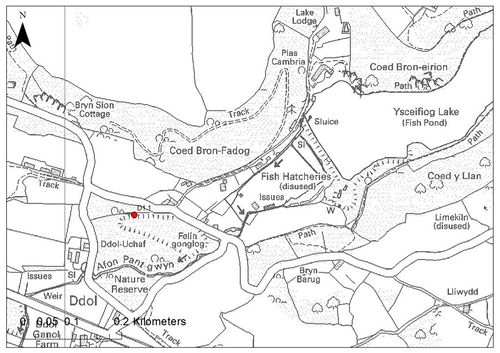
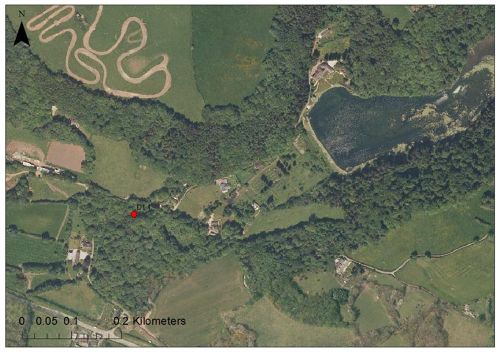
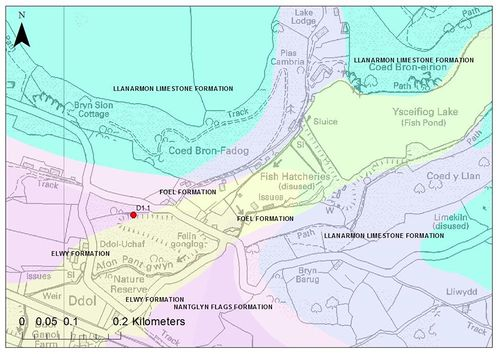
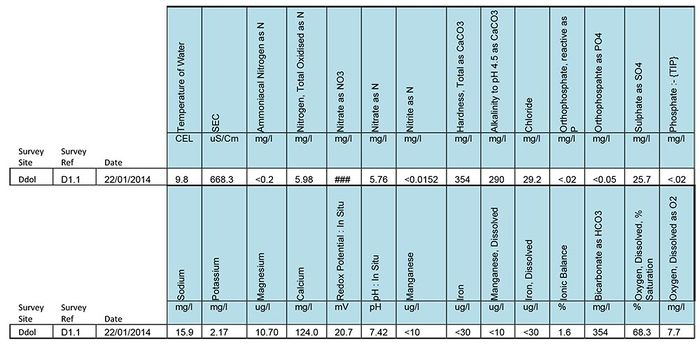
Vegetation (spring) for Ddol
An old quarried tufa site that has developled into secondary woodland. A tiny stand of Palustriella commutata was found at the base of a damp block of tufa beside a small stream (overflow from a pond nearby). A small number of associates include Crataneron filicinum, Pellia endiviifolia and Chrysosplenium oppositifolium
| Chrysosplenium oppositifolium | R |
| Cratoneuron filicinum | A |
| Palustriella commutata | F |
| Pellia endiviifolia | O |
| Plagiomnium undulatum | R |
Old (and friable) tufa blocks dominated by Leicolea turbinataa and Fissidens taxifolius var. taxifolius.
| Asplenium scolopendrium | O |
| Bryoerythrophyllum recurvirostrum | R |
| Bryum capillare | R |
| Conocephalum conicum | O |
| Fissidens taxifolius var. taxifolius | F |
| Geranium robertianum | R |
| Hedera helix | O |
| Leicolea turbinata (per., cap.) | F |
| Thamnobryum alopecurum | O |
Vegetation (adjoining spring) for Ddol
Secondary woodland with a ground flora dominated by Asplenium scolopendrium. The ground flora is very sparce and open as the soil (including previously quarried tufa) is very loose and friable.
| Asplenium scolopendrium | F |
| Brachypodium sylvaticum | R |
| Brachythecium rutabulum | O |
| Corylus avellana | O |
| Didymodon insulanus | R |
| Dryopteris felix-mass | R |
| Eurhynchium striatum | O |
| Fissidena taxifolius var. taxifolius | F |
| Fraxinus excelsior | F |
| Geranium robertianum | R |
| Geum urbanum | R |
| Hedera helix | A |
| Lapsana communis | R |
| Lophocolea bidentata | R |
| Oxyrrhynchium hians | R |
| Pellia endiviifolia | O |
| Polystichum setiferum | R |
| Potentilla steralis | R |
| Ribes uva-crispa | R |
| Rosa canina agg. | R |
| Taraxacum sp. | R |
| Urtica dioica | R |
Emergent and aquatic vegetation associated with a small stream (overflow from a pond nearby).
| Epilobium hirsutum | R |
| Lemna trisulca | R |
| Ranunculus repens | R |
| Ranunculus sp. (Subgenus Batrachium) | R |
| Veronica beccabunga | O |
Condition assessment
The overall assessment is that Ddol should be classified as being in favourable ecological and hydrogeological condition.
